Products
Describes a use case for Optimizely Configured Commerce products.
Scenario
Hero Tools' Product Manager, Elizabeth Osero, is working with her team to implement Hero's product catalog in their Optimizely Configured Commerce solution. They plan to integrate Configured Commerce's product information management with Hero's ERP solution, but would like to understand how Configured Commerce's constructs work before they create the integration. Together with her team members Markus Hayes (Content Specialist) and Jonathan Crane (Technical Writer), Elizabeth sets out to learn everything she can about Insite's catalog options before the project begins.
Catalog structure
Configured Commerce's catalog structure is built on the idea of categories. Categories may be nested (sometimes called parent/child categories), or stand-alone, depending on business needs.
Elizabeth has already worked with the Hero project team to determine which categories they will add to their site for Phase 1. Since Hero's customers generally browse or search their site based on product type (such as "power tools" or "accessories") instead of by vendor, the team has determined to sort and separate products based on type. Elizabeth names a category "Power Tools," and creates four child categories for it: "Nailers and Staplers," "Grinders," "Impact Drivers," and "Rotary Hammers.' Site visitors still may search for products, of course, but if they aren't quite sure what they are looking for, this simple taxonomy allows site visitors to start with the type of tool they want, and proceed from there.
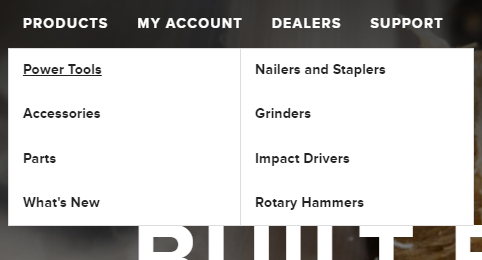
Dynamic categories
Dynamic Categories are product categories whose contents can shift based on a set of predefined rules. Dynamic Categories also are a quick way to group dissimilar products together, without having to assign them to a category manually.
One of Hero Tools' goals for the fiscal year is to introduce ten new products every month, and convert the best-performing ones to permanent catalog status by end of year. To encourage site visitors to view and purchase new products, Elizabeth creates a Dynamic Category called What's New. For rules, she sets up that the Activate On Source Data Field must be between 1/1/2018 and 1/31/2018. Once she rebuilds the index, the category populates with all products added to the system in January 2018.
Once February hits, all Elizabeth needs to do is edit the category, and change the date range to 2/1/2018 and 2/28/2018. The category will repopulate with all products added to the system in February 2018, without having to build an entirely different category.
Variant products
A variant product is a type of product that has several different purchase options available. Those options might be based on a product's size, color, fabric, or a combination of features.
Hero Tools recently started carrying a line of toolboxes. While the toolboxes look similar, and have similar features, they come in three sizes (Small, Large, and X-Large), and each size comes in three colors (Yellow, Red, and Blue). Instead of building a unique product page for each color/size combination, Content Specialist Markus Hayes recommends turning the Hero Toolbox into a Variant Product. This way, when a site visitor browses or searches for the toolbox, they only need to visit one product page; from there, they can select their color/size combination from the drop-downs, and add the item to their cart.
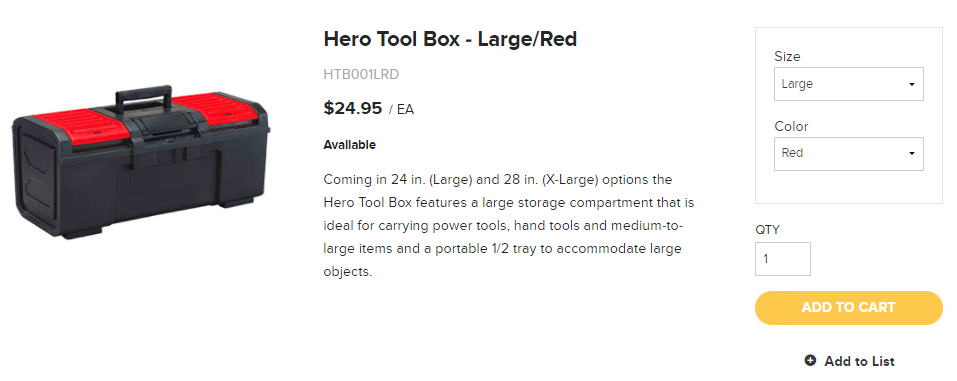
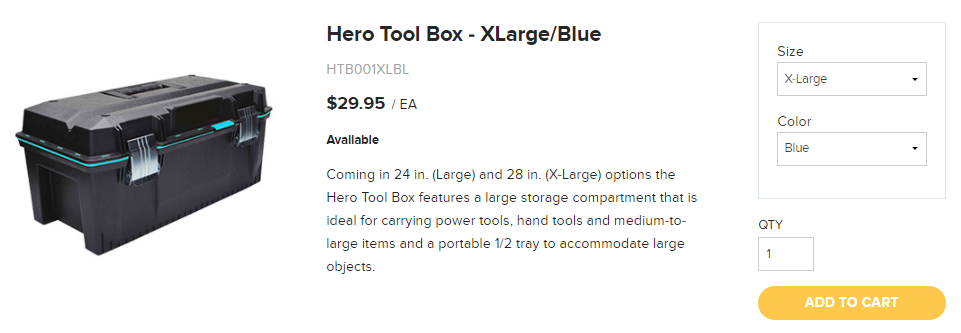
Product configurations
Use Product Configurations to create kits and bundles, or groupings of products a site visitor may wish to purchase together (usually at a slight discount compared to purchasing the items separately). Fixed configuration products have preset options, while standard configurations allow site visitors to select their bundle from multiple preselected products.
After an especially aggressive buying quarter, Hero Tools finds itself with a surplus of nails and staples. While their customers enjoy purchasing their power tools from Hero, they appear to go elsewhere to purchase additional accessories. After a consultation with the procurement team, Elizabeth decides to use Configured Commerce's product configurations to create preconfigured (or "fixed") bundles. Each bundle contains one power tool, three boxes of the appropriate nails or staples, and an additional charger. The bundles are marked 10-15% higher than the power tool alone. This provides the customer with a great deal on accessories and ensures they are ordering the correct ones while alleviating Hero's backstock issue.
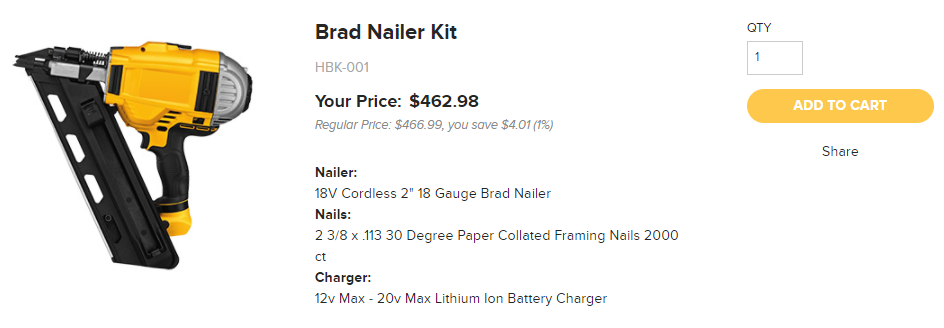
Attributes
Attributes are qualities assigned to a product, like Length, Type, or Color. Once attributes are assigned to products, site visitors may use them to curate the products displayed in a category, or narrow search results. Attributes themselves are also searchable.
Hero Tools sells several power tools with long, specific names, like 20V Max* Brushless Impact Driver Kit. This product, HID-765-K, is also cordless, but Markus doesn't want to add an additional word to the product's title. He chooses to create an attribute called Power Tool Type (assigned to the Impact Drivers category), and an attribute value of Cordless (assigned to the product). After rebuilding the index, Markus searches for "cordless" on the website, and HID-765-K appears alongside other cordless products in the search results. Markus can even select the "Cordless" option on the left side of the screen to narrow his search results even further.

Cross sells
Cross Sells encourage site visitors to purchase products related to the product they are currently viewing. Product Cross Sells display related products on the product detail page, while Web Cross Sells display selected products anywhere the Product Carousel widget's Web Cross Sells Carousel Type exists.
Every month, Hero chooses a vendor and provides a 10% discount on that vendor's products. Markus would like to include some of the vendor's products on the Home page to encourage users to view and purchase the vendor's best sellers. Elizabeth suggests he add a Product Carousel widget to the Home page, and select the Web Cross Sells Carousel Type. Markus then adds ten of that month's vendor's products under the website's Cross Sells finger tab in the Admin Console. Each month, Markus returns to the Cross Sells finger tab and swaps out the products for the new featured vendor.
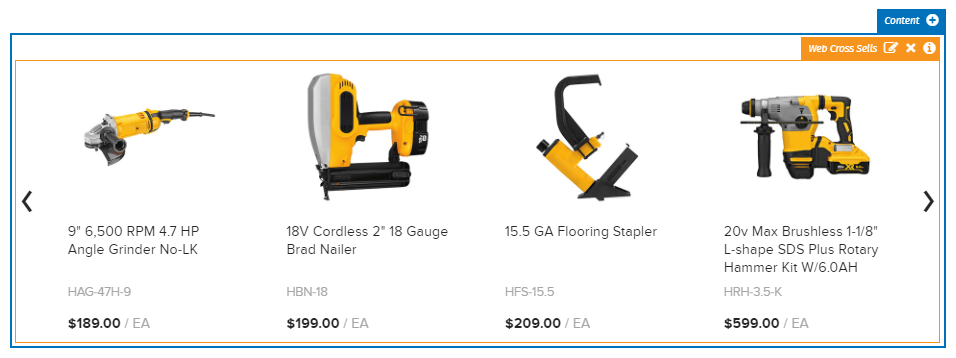
Elizabeth is looking for a way to increase sales of nails, staples, and other tool accessories/parts when site visitors purchase a power tool. She decides to add Product Cross Sells to HBN-18, Hero's best-selling cordless brad nailer, as a test. In the Admin Console, Elizabeth adds the matching nails, replacement charger, and replacement battery pack to HBN-18's Cross Sells finger tab in the Admin Console. After some user testing, Elizabeth decides to add Cross Sells to all of Hero's power tools products. She accomplishes this by using product import (see below).
Restriction groups
Use restriction groups to prevent/allow a customer to view and/or purchase a product. Customers may belong to multiple restriction groups. Show restriction groups show products that would otherwise be hidden, Hide restriction groups hide products that would otherwise be shown, and Show Only restriction groups override all other restriction groups set on a product. Products also can be set to Hide or Show individually.
Hero Industries recently began selling a test sample of HVAC products through one of its subsidiaries, Victory Distribution. Their HVAC Vendor, Design Heating and Cooling (DHC), has signed a distribution contract with Victory on the condition that DHC's products are sold only in the state of Connecticut. Elizabeth marks all DHC's products with a default behavior of Hide, then creates a restriction group showing those products only to signed-in users with a Ship To State of Connecticut.

Along with the new line of HVAC products, Victory Distribution also began carrying various types of industrial coolant. Since these coolants are considered hazardous materials, Victory cannot ship them over the border to their customers in Canada. To ensure compliance, Elizabeth creates a restriction group hiding all products in the Industrial Coolant category from users whose customer Ship To Country is Canada.
Updated 4 months ago